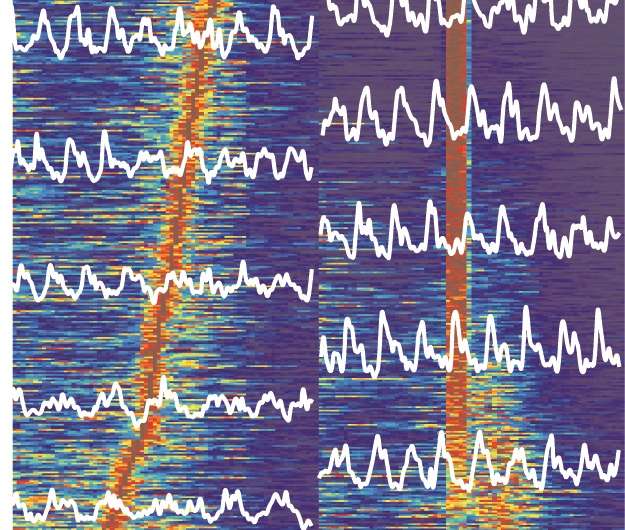Theta oscillations coordinate navigation and movement

Using light pulses, Berlin scientists have recently managed to control theta oscillations in mouse brain. They discovered that these brain waves coordinate movement - enabling signaling between distant brain regions – a common code for controlling mental states and behavior.
Theta oscillations were discovered in Berlin-Buch almost 80 years ago, but despite decades of intensive research, the function of this rhythm remained elusive due to the lack of tools to experimentally control and manipulate it. Theta waves occur in several brain regions, including the hippocampus, a part of the brain where so-called "place cells" code the specific location of animals or humans during navigation. But up until recently, it was not known how or whether theta oscillations could control behavior during exploration.
A team of researchers led by Tatiana Korotkova and Alexey Ponomarenko at the FMP Institute/NeuroCure Cluster of Excellence in Berlin used optogenetics to control theta oscillations in mice. They targeted light-sensitive molecules at neuronal connections from the main pacemaker of the theta rhythm to the hippocampus, and excited these pathways using an optic fiber. "It was fascinating to see that such a major part of brain network activity – the theta rhythm – simply followed the pace of the light which we shone into the brain" - recall Ph.D. students Franziska Bender and Maria Gorbati.
Optogenetic control 'fine-tuned' theta oscillations, rendering them more regular, and isolating them from other influences such as sensory inputs. Therefore, this method opened the way to answering long-standing questions about the impact of theta rhythmic activity on behavior. Here the first surprise awaited researchers: as the rhythm in hippocampus was optogenetically regularized, mice changed the way they moved through environment. The animals moved slower and with a more constant speed depending on the experimentally adjusted regularity of theta oscillations.
"Brain rhythms work like traffic lights, which signal when certain neural cells should fire and when they should stay silent", summarized Alexey Ponomarenko. "More regular oscillations act as green traffic lights repeated with regular intervals. With orderly theta oscillations, activity of many 'vehicles' – populations of cells in hippocampus - appears to be more consistent over time".
The second surprise was that not only cortex, but also other, evolutionally much older, brain regions responded to the "traffic lights" in hippocampus, and participated in adjustment of animals' behavior. Hippocampal theta waves are transferred via the lateral septum to hypothalamus – an important brain control center which integrates vital signals including hunger and arousal. "For many years, role of hippocampal oscillations in spatial coding and memory was studied to understand how we remember our everyday experiences" – says Tatiana Korotkova. "Now we know that the 'cognitive' picture of environment constructed by hippocampus is also read out by brain regions which are able to directly regulate exploratory activity."
The brain is composed of many interlocking networks with immensely different organization, including different neural 'languages', which still need to work together to ensure an organism's survival. "We already knew that brain networks communicate via synchronization, but our 'dictionary' for decoding this activity though has never been tested in a conversation. Using optogenetics, it's now possible to participate in this communication, to learn exact meaning of signaling or words in the synchronization vocabulary, and to expand our dictionary" - explains Alexey Ponomarenko. The researchers are convinced that real-time optogenetic manipulation of neural network oscillations can further help to uncover causal role of brain dynamics in behavior, and also promote mechanistic understanding of mental disorders.
More information: Franziska Bender et al. "Theta oscillations regulate the speed of locomotion via a hippocampus to lateral septum pathway," Nature Communications (2015). DOI: 10.1038/NCOMMS9521

















